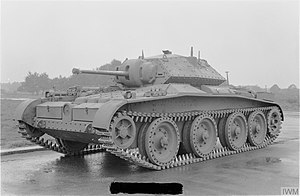Covenanter tank
| Covenanter cruiser tank | |
|---|---|

Tank, Cruiser, Mk V, Covenanter (A13 Mk III)
|
|
| Type | Cruiser tank |
| Place of origin | United Kingdom |
| Service history | |
| In service | 1940–1943 |
| Production history | |
| Designer | LMS/Nuffield (turret) |
| Manufacturer | LMS, English Electric Leyland Motors |
| No. built | 1,771 |
| Specifications | |
| Weight | 18 long tons (18 t) |
| Length | 19 ft 0 in (5.79 m) |
| Width | 8 ft 7 in (2.62 m) |
| Height | 7 ft 4 in (2.24 m) |
| Crew | 4 (commander, gunner, loader, driver) |
|
|
|
| Armour | 7–40 mm (0.28–1.57 in) |
|
Main
armament |
QF 2-pounder (40 mm) |
|
Secondary
armament |
7.92 mm Besa machine gun (coaxial) |
| Engine |
Meadows D.A.V flat-12 340 hp (250 kW) |
| Power/weight | 18.6 hp (13.9 kW) / tonne |
| Transmission | Meadows gearbox with Wilson epicyclic steering |
| Suspension | Christie |
| Fuel capacity | 92 imperial gallons (420 l) |
|
Operational
range |
100 mi (160 km) |
| Speed | 30 mph (48 km/h) |
The Cruiser tank Mk V or A13 Mk III Covenanter was a British cruiser tank of the Second World War. The Covenanter was the first cruiser tank design to be given a name. Designed by the London, Midland and Scottish Railway as a better-armoured replacement for the Cruiser Mark IV, it was ordered into production in 1939 before pilot models were built. Problems with the design only became apparent after production was under way.
The tank equipped various British armoured divisions in the home defence and training roles. It never left the British Isles as poor engine cooling caused versions MkI-MkIII to be declared unfit for use overseas service especially in hot climates. This was rectified in the MkIV after many corrective actions were undertaken but by February 1944, it was declared obsolete. More than 1,700 of the type were built.
It was named after the Covenanters, a Scottish religious faction in the British Isles at the time of the Wars of the Three Kingdoms.
In 1938, the War Office had issued a requirement for a new, better armoured "heavy" cruiser tank to replace the Cruiser IV. Nuffield's A16 (and the A14) design was found to be too expensive and, in 1939, a cheaper and lighter cruiser tank – under General Staff specification A13 Mk III Cruiser Mark V – was chosen to be developed. It had nothing apart from Christie suspension and armament in common with the other A13 specifications.
The initial specification required a QF 2 pounder gun, at least one machine gun, the same A13 Christie suspension in a lower hull,epicyclic steering transmission and "armour standard" of 30 millimetres (1.2 in). The "30 mm armoured standard" referred to any vertical plate having to be 30 mm thick. Angled surfaces (through the principles of sloped armour) could be thinner, provided they were at least as effective as a 30 mm thick vertical plate.
...
Wikipedia
